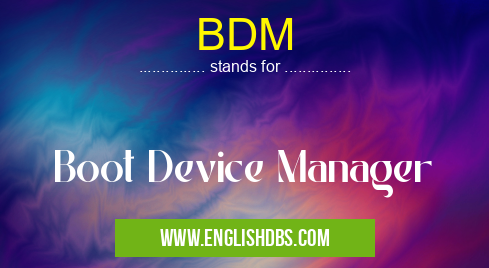What does BDM mean in UNCLASSIFIED
BDM stands for Boot Device Manager, a software system used to boot and control a computer's startup process. It is generally part of a firmware program in the computer's ROM (Read-only Memory) or BIOS (Basic Input/Output System). BDM typically determines which programs, devices, and settings need to be loaded in order to start up the computer properly. The boot sequence begins with BDM launching the first program on the startup list.

BDM meaning in Unclassified in Miscellaneous
BDM mostly used in an acronym Unclassified in Category Miscellaneous that means Boot Device Manager
Shorthand: BDM,
Full Form: Boot Device Manager
For more information of "Boot Device Manager", see the section below.
What is Boot Device Manager
Boot Device Manager (BDM) is an important utility that helps manage system startup processes. This allows computers to be powered up quickly and without errors. BDM becomes active when power is supplied to the system and controls which programs are launched during startup. Depending on the design of the computer, BDM may reside within BIOS (Basic Input/Output System). BIOS is generally integrated into a read-only memory chip or PROM (Programmable Read-Only Memory).
When power is supplied to a system that has been switched off or reset, BDM starts with whichever device is set as its highest priority in terms of boot order. After the initial device has been initialized it then continues with successive devices until all essential components have been identified and loaded correctly by BDM into RAM (Random Access Memory) prior to startup being completed.
Essential Questions and Answers on Boot Device Manager in "MISCELLANEOUS»UNFILED"
What is Boot Device Manager (BDM)?
Boot Device Manager, or BDM, is a software application used to configure boot devices in a computer system. It is designed to provide an interface between the BIOS and the operating system of a given system, so that the different components can interact correctly. BDM can also be used to troubleshoot issues with conflicting boot devices and manage startup sequences.
What are some features of BDM?
The features of Boot Device Manager vary depending on the specific version and platform it is installed on. Generally speaking, BDM will allow users to view information about installed boot devices, configure order of priority for startup devices, add new boot options, set up secure boot settings, update firmware for certain devices, and create specialized boot menu entries among other things.
How do I access Boot Device Manager?
On most systems running Windows Operating Systems, you can access Boot Device Manager from the System Configuration Utility by selecting ‘Advanced Options’ and then ‘Boot Configuration’. On Linux systems you will need to install BDM prior to use; once installed it should appear in your System Settings as an additional option. For Mac OSX systems you will need to restart your computer while holding down ‘Option’ key during startup in order to access the Boot Manager selection screen.
How often should I check my BDM settings?
You should review your Boot Device Manager settings at least once a month to make sure they are configured properly and up-to-date according to your needs. Changes made in this area could potentially disrupt normal functioning of your system so it is important that you frequently review these changes in case any unexpected issues arise.
What type of applications does BDM support?
Boot Device Manager supports a wide variety of applications including Windows/DOS programs like MS-DOS and Japanese DOS; Unix-like distributions such as FreeBSD; open source operating systems such as GNU/Linux; Apple Mac OS X; Sony Playstation 2; Microsoft Xbox 360; Nintendo GameCube; Sun Solaris; IBM AIX; HP OpenVMS etc.
Is there any risk using BDM?
Yes, improper use of Boot Device Manager could lead to conflicts between different components involved in the booting process which might inhibit normal functioning or even damage hardware components within your system if not handled correctly. Therefore it is important that any changes made with BDM be done with caution and consideration for potential risks before proceeding.
Can I use other software besides BDM?
Yes – there are other software programs available which provide similar functionality such as Clover EFI or EasyBCD which can be used instead of Boot Device Manager depending on what kind of configuration you want for your system's boot setup specifically.
Are there any alternative methods for accessing BDM aside from Windows or Linux based platforms?
Yes – some users opt to use external media such as flash drives or CD/DVD ROMs in order to gain access into their computers' BIOS settings more quickly than via conventional means through normal operation systems alone. This way users have direct control over device ordering without needing additional software programs like BDM installed onto their computers beforehand.
Final Words:
In short, Boot Device Manager (BDM) plays an essential role in managing system's startup process and ensuring successful loading of all necessary components prior launching them into memory during initialization phase whenever power supply gets resumed in computing systems. At times it may become necessary for users to configure certain settings within BDM if basic operations do not take place due to compatibility issues between devices installed within their setup; although most modern computers come preconfigured with appropriate settings already set prior purchase so no reconfiguring should be needed in general circumstances.
BDM also stands for: |
|
| All stands for BDM |
